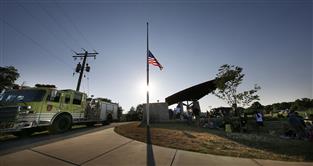Wauwatosa man's dream 'Ability Center' could have $15 million annual impact, study finds
Wauwatosa resident Damian Buchman knows he is a medical anomaly, having twice survived bone cancer in his legs as a young teenager. That's why he's dedicated his career to helping other people with disabilities lead healthier lives.
"The fact that I'm standing on my own two feet is part of my blessing," Buchman said. "This is part of my service for surviving."
His goal: The Ability Center, an athletic and recreational facility designed specifically for people with disabilities. The ambitious project has been several years in the making, but TAC is gaining more traction recently after securing nearly $1 million in donations and completing studies that attest to its economic feasibility and impact.
"These studies are showing this is real, and we could be a leader in this arena, as opposed to someone who adapts and follows," said TAC board member Diane Braza, who is chair of the Department of Physical Medicine and Rehabilitation at the Medical College of Wisconsin.
Buchman hopes to build the 4.5-acre center at the Milwaukee Regional Medical Center, where doctors and researchers could use it for studies and for rehabilitating patients.
Studies show promise
TAC's economic feasibility study, prepared by Sports Facilities Advisory, gave the project a thumbs up for viability due to the lack of accessible facilities in the area, the central location of the MRMC, local partnerships, and market demand for court sports.
The economic impact study, by Leib Advisors, estimated TAC could generate about $15 million in economic activity per year. That includes TAC expenses, spending by TAC visitors, and the secondary spending that occurs as a result of these visitors (like hotels buying more cleaning supplies to accommodate more guests).
Much of this impact depends on TAC being an international draw for big competitions like the Special Olympics, which is Buchman's goal. The facility plans include a track, fitness center, climbing wall, several pools, 12 volleyball courts, and six basketball courts. All sports would have accommodations for different disabilities, such as wheelchair basketball and goal ball, a sport designed for people with blindness.
Leib Advisors estimated the average visitor to TAC would spend about $339 locally per 24 hours, including lodging, transportation, retail and entertainment. In the first year, the study estimates visitors to the facility will spend about $4.5 million in the area.
Buchman hopes these studies will help his case as he works to gain the support of the MRMC and Milwaukee County Board, as the land is owned by the county. His goal is to get a plot of land at the MRMC approved for TAC next June.
Bob Simi, recently hired as MRMC's new executive director, said he supported the Buchman's idea, but noted that land on the medical campus is highly competitive.
"It's extremely valuable property," Simi said. "We will have to give it thorough due diligence to see if it's the right location."
Collaboration key
Buchman said the MRMC location is ideal because of the potential collaborations with medical facilities, and the attractive location for both disabled and able-bodied members.
Buchman said TAC could be a living laboratory for students and professors who are studying and designing products for rehabilitation.
Braza, a SpineCare physician, said the facility could help many of her patients exercise who otherwise would struggle to stay fit.
"There's a real health concern about keeping people with disabilities active," she said. "Many of our patients would benefit from the accommodations, like an adaptive yoga program."
Buchman also hopes to build bridges with the able-bodied public. He's counting on them buying memberships to help fund scholarships on sliding scales for disabled members. Disabled people are more likely to live in poverty, and fitness options for them can be much more expensive.
"Your shoes are your wheelchair and that wheelchair is $2,500," Buchman said.
He envisions people with and without disabilities playing sports side-by-side, for once on equal playing fields in a place that's not just designed to accommodate disabilities, but created to welcome them.
"It's a pride and dignity thing," Buchman said. "Have a lot of them gotten used to not having that universal design? Sure. But is it right? Here, they will feel welcome, wanted and comfortable."
For more information on The Ability Center, visit www.tacwi.org.
More from News and Features
- Anodyne Coffee plans to open location in Wauwatosa Village
- Wauwatosa Meetings: Aug. 4
- Video: Wauwatosa girl's curbside ice cream stand raises money for the hungry
- Wauwatosa News and Notes: Hands-only CPR training offered; Firefly Art Fair is Aug. 6-7
- Wauwatosa Ask Now: Why are there barriers and fencing along the North Avenue bridges over the Menomonee River?
- Mystery Photo Contest: July 28
- Wauwatosa gears up for National Night Out event, this year at the zoo
- Election 2016: Wisconsin's 4th District candidates weigh in
- Wauwatosa's Luther Manor residents share smiles through flower delivery
- Wauwatosa Police Report: July 17-23















